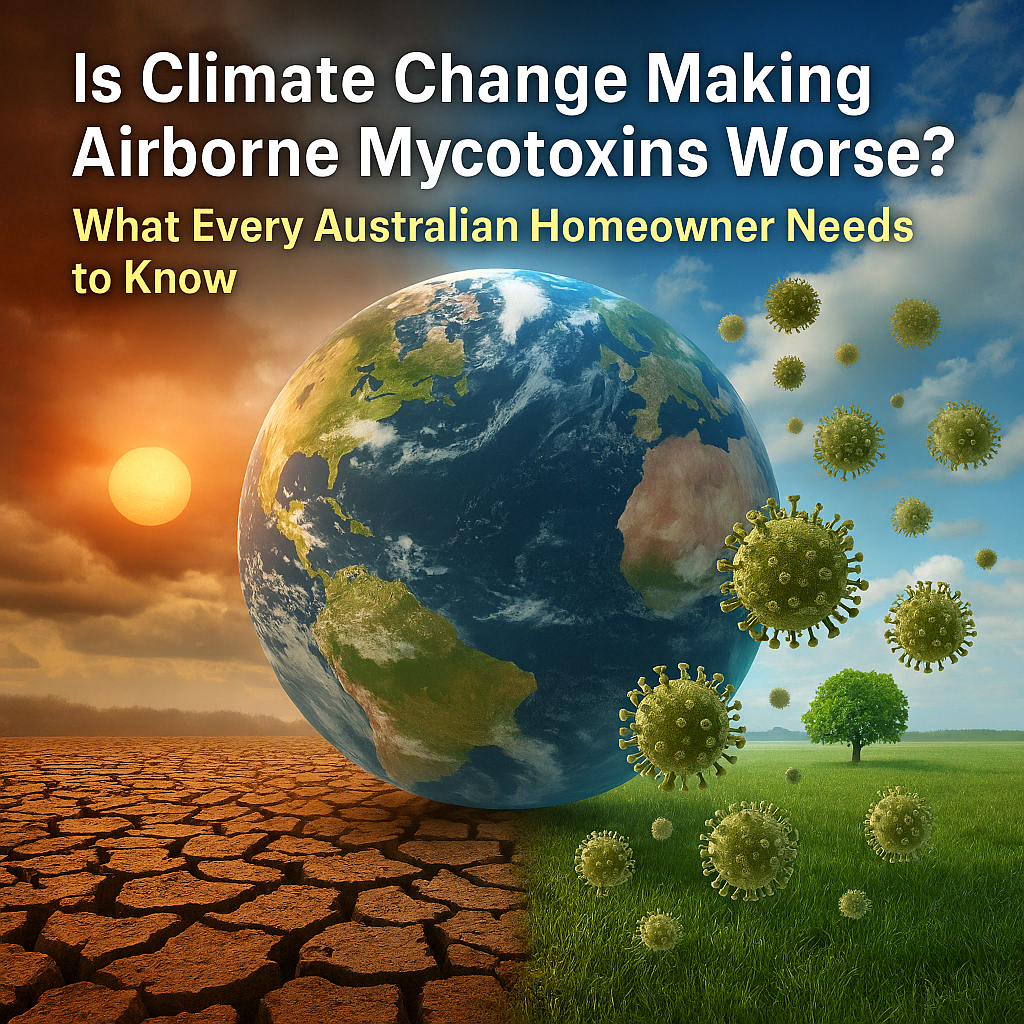
Is Climate Change Making Airborne Mycotoxins Worse? What Every Australian Homeowner Needs to Know
Introduction
Mould is more than just an unsightly problem—it’s a biological hazard that can compromise your health and damage your property. As it grows, it can release dangerous toxins into the air called mycotoxins. When these mycotoxins become airborne, they can be inhaled without you even knowing.
Now, with climate change driving hotter, wetter, and more humid conditions, these threats are growing faster than ever. Shifting weather patterns mean more homes, businesses, and cool rooms are becoming ideal breeding grounds for toxic mould.
That’s why The Mould Group continues to lead the way in mould detection, testing, and safe remediation across Australia. They help property owners stay safe—even as environmental conditions worsen.
What Are Airborne Mycotoxins and Why Are They Dangerous?
Airborne mycotoxins are microscopic toxins released by certain types of mould, including Aspergillus, Penicillium, and Stachybotrys (black mould). These toxins float in the air and can settle on surfaces—or worse—be inhaled into the lungs.
They are invisible, odourless, and incredibly dangerous. In some environments, they’ve been linked to long-term health conditions ranging from fatigue and allergies to neurological and liver problems.
As climate change intensifies mould growth, the risk of exposure is increasing.
How Can Airborne Mycotoxins Affect Your Health?
When inhaled or ingested, airborne mycotoxins can trigger a wide range of symptoms:
Coughing, wheezing, or shortness of breath
Headaches and brain fog
Chronic fatigue or weakness
Skin rashes and irritation
For children, the elderly, and those with respiratory issues or weakened immune systems, the effects can be much more severe—even life-threatening.
What Environmental Changes Are Causing More Mycotoxins in the Air?
Climate change is fuelling the perfect storm for mould to thrive indoors and outdoors. Key factors include:
Increased humidity due to warmer temperatures
More frequent flooding and storms damaging homes
Longer wet seasons leading to water accumulation
Rising condensation levels in homes without proper ventilation
Cool rooms, basements, and poorly ventilated bathrooms in cities like Sydney are especially vulnerable. Even small leaks or poor insulation can trigger a mould outbreak in today’s changing climate.
How Can You Test for Airborne Mycotoxins in Your Home?
Identifying airborne mycotoxins early is key to protecting your home and health. Here are the most effective methods used by professionals:
Air sampling devices to trap and analyse airborne toxins
Dust testing to identify long-term mould exposure
Thermal imaging to find hidden moisture inside walls
Humidity checks to reveal areas prone to condensation
Surface swabbing for visible mould colonies
The Mould Group offers comprehensive testing using cutting-edge technology—ensuring nothing is left to chance.
What Are the Best Ways to Remove Airborne Mycotoxins?
If your home is contaminated, removing airborne mycotoxins safely requires more than just bleach. Here’s what works:
HEPA filtration systems to purify indoor air
Industrial-grade air scrubbers for high-risk areas
Safe removal of contaminated materials like carpets and insulation
Anti-fungal treatments on walls, ceilings, and surfaces
Professional cleaning services from certified mould experts
Never attempt to clean a severe mould problem yourself. You could release even more spores into the air—making things worse.
How Can You Prevent Mycotoxin Contamination?
Prevention starts with understanding your environment. These steps make a big difference:
Use exhaust fans in bathrooms, kitchens, and laundry rooms
Check roofing and gutters regularly for leaks
Seal windows and wall cracks to block moisture intrusion
Store items off the floor in basements and cool rooms
Use dehumidifiers to control indoor humidity
Don’t wait until you see mould—prevent it before it grows.
Who Is Most at Risk from Airborne Mycotoxins?
While everyone can be affected by airborne mycotoxins, these groups are especially at risk:
Young children with developing respiratory systems
Seniors with compromised immunity
Asthma sufferers or those with chronic lung issues
Pregnant women
Renovators disturbing old mould hidden in walls
Business owners in food service with poorly maintained cool rooms
Homes in flood-prone or humid regions are also more susceptible, especially as climate patterns shift.
Why Inspections Matter More Than Ever
As we discussed in Mould Testing vs Full Inspection: What’s the Cost Difference in Brisbane?, not all tests provide the full picture. DIY kits only show surface mould—and often miss airborne toxins entirely.
A full inspection with The Mould Group includes:
Advanced sampling methods
In-depth moisture mapping
Internal cavity assessments
Prevention planning for ongoing protection
With climate change making conditions worse, inspections are no longer optional—they’re essential.
What’s Next? A Deeper Look at Inspection Costs
Curious about how much a thorough mould inspection costs?
In our next article, How Much Does a Mould Inspection Cost in Brisbane? A Complete Breakdown, we cover all the pricing details—from simple testing to complete remediation.
You’ll get the information you need to make the right call—before health or property damage gets out of hand.
Don’t let rising mould threats catch you off guard.
Contact The Mould Group today for expert air testing and remediation—before the damage is done.
🔗 Want updates and case studies from real homes? Follow us on Facebook: The Mould Group Facebook Page
📝 Next blog in this series:
Emerging Research: What We Still Don’t Know About Airborne Aflatoxins
Recent Post
Emerging Research
Are Airborne Aflatoxins More Dangerous Than We Thought? Emerging Research Reveals the Unknowns Introduction Mould is not just a cosmetic nuisance. It’s a living organism that, when left unchecked, releases toxic by-products into your environment. One of the most concerning of these by-products is aflatoxin—a dangerous type of airborne mycotoxin. While we know that ingesting […]
Climate Change and Airborne Mycotoxins
Is Climate Change Making Airborne Mycotoxins Worse? What Every Australian Homeowner Needs to Know Introduction Mould is more than just an unsightly problem—it’s a biological hazard that can compromise your health and damage your property. As it grows, it can release dangerous toxins into the air called mycotoxins. When these mycotoxins become airborne, they can […]
Airborne Aflatoxins and Animals
Are Your Pets or Livestock at Risk? Understanding Airborne Aflatoxins and Animals Introduction Mould is not just a concern for homes and people—it also poses a serious threat to animals. When mould spreads in barns, sheds, feed storage areas, or even inside homes, it can release aflatoxins—a dangerous type of airborne mycotoxin. These toxins can […]



